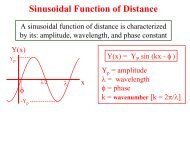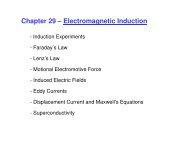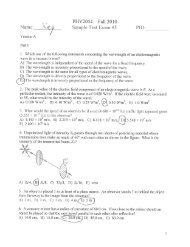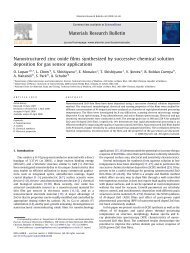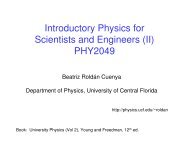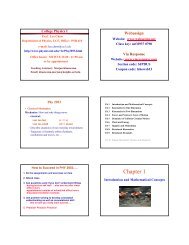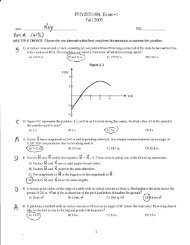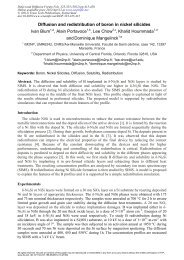2-D Motion - UCF Physics
2-D Motion - UCF Physics
2-D Motion - UCF Physics
Create successful ePaper yourself
Turn your PDF publications into a flip-book with our unique Google optimized e-Paper software.
Chapter 3 – 2D and 3D <strong>Motion</strong><br />
I. Definitions<br />
II.<br />
Projectile motion<br />
III. Uniform circular motion<br />
IV. Relative motion
I. Definitions<br />
Position vector: extends from the origin of a coordinate system to the particle.<br />
<br />
r = xiˆ<br />
+ yj ˆ +<br />
zkˆ<br />
(4.1)<br />
Displacement vector: represents a particle’s position change during a certain<br />
time interval.<br />
<br />
∆r<br />
=<br />
<br />
r ( )ˆ ( ) ˆ ( ) ˆ<br />
2 − r1<br />
= x2<br />
− x1<br />
i + y2<br />
− y1<br />
j + z2<br />
− z1<br />
k<br />
(4.2)<br />
Average velocity:<br />
<br />
v avg<br />
=<br />
<br />
∆r<br />
∆t<br />
=<br />
∆x<br />
iˆ<br />
+<br />
∆t<br />
∆y<br />
∆t<br />
ˆj<br />
+<br />
∆z<br />
∆t<br />
kˆ<br />
(4.3)
Instantaneous velocity:<br />
<br />
v = v<br />
iˆ<br />
+ v<br />
ˆj<br />
+ v<br />
kˆ<br />
<br />
dr<br />
dt<br />
dx<br />
iˆ<br />
+<br />
dt<br />
dy<br />
dt<br />
x y z = = +<br />
ˆj<br />
dz<br />
dt<br />
kˆ<br />
(4.4)<br />
-The direction of the instantaneous velocity of a<br />
particle is always tangent to the particle’s path at<br />
the particle’s position<br />
Average acceleration:<br />
<br />
a avg<br />
=<br />
<br />
v2<br />
− v<br />
∆t<br />
1<br />
=<br />
<br />
∆v<br />
∆t<br />
(4.5)<br />
Instantaneous acceleration:<br />
<br />
a =<br />
a<br />
iˆ<br />
+ a<br />
ˆj<br />
+ a<br />
kˆ<br />
<br />
dv<br />
dt<br />
dv<br />
dt<br />
dv<br />
iˆ<br />
+<br />
dt<br />
x y<br />
x y z = =<br />
+<br />
ˆj<br />
dv<br />
dt<br />
z<br />
kˆ<br />
(4.6)
II. Projectile motion<br />
<strong>Motion</strong> of a particle launched with initial velocity, v 0 and free fall acceleration<br />
g.<br />
The horizontal and vertical motions are independent from each other.<br />
- Horizontal motion: a x =0 v x =v 0x = constant<br />
x − x0 = v0xt<br />
= ( v0<br />
cosθ0)<br />
t<br />
(4.7)<br />
Range (R): horizontal distance traveled by a<br />
projectile before returning to launch height.<br />
- Vertical motion: a y = -g = constant<br />
2<br />
1<br />
y − y0 = v0<br />
yt<br />
− gt = ( v0<br />
sinθ0)<br />
t − gt<br />
2<br />
2<br />
1 2<br />
(4.8)<br />
v y<br />
= v 0 sinθ 0 − gt (4.9)<br />
v y = ( v0<br />
sinθ0)<br />
− 2g(<br />
y − y0)<br />
(4.10)<br />
2<br />
2
- Trajectory: projectile’s path.<br />
x<br />
0 = y0<br />
=<br />
0<br />
( 4 .7 ) + ( 4 .8 ) →<br />
y = (tan<br />
θ<br />
0<br />
) x −<br />
t =<br />
v<br />
2 ( v<br />
0<br />
0<br />
gx<br />
cos<br />
x<br />
cos<br />
2<br />
θ<br />
θ<br />
0<br />
)<br />
0<br />
2<br />
→<br />
y<br />
= v<br />
0<br />
sin<br />
( 4 .11 )<br />
θ<br />
0<br />
v<br />
0<br />
x<br />
cos<br />
θ<br />
0<br />
−<br />
1<br />
2<br />
g<br />
⎛<br />
⎜<br />
⎝<br />
v<br />
0<br />
x<br />
cos<br />
θ<br />
0<br />
⎞<br />
⎟<br />
⎠<br />
2<br />
→<br />
- Horizontal range: R = x-x 0 ; y-y 0 =0.<br />
R = ( v<br />
0 = ( v<br />
0<br />
0<br />
cosθ<br />
) t<br />
sinθ<br />
) t −<br />
0<br />
0<br />
→ t =<br />
1<br />
2<br />
gt<br />
2<br />
v<br />
0<br />
R<br />
cosθ<br />
= ( v<br />
0<br />
0<br />
sinθ0)<br />
v<br />
0<br />
R<br />
cosθ<br />
0<br />
−<br />
1<br />
2<br />
⎛<br />
g<br />
⎜<br />
⎝ v<br />
0<br />
R<br />
cosθ<br />
0<br />
⎞<br />
⎟<br />
⎠<br />
2<br />
=<br />
R tanθ<br />
0<br />
−<br />
1<br />
2<br />
g<br />
v<br />
2<br />
0<br />
R<br />
2<br />
cos<br />
2<br />
θ<br />
0<br />
→<br />
R<br />
=<br />
2sinθ0<br />
cosθ0<br />
g<br />
v<br />
2<br />
0<br />
=<br />
2<br />
0<br />
v<br />
g<br />
sin 2θ<br />
0<br />
(4.12)<br />
(Maximum for a launch angle of 45º )<br />
Overall assumption: the air through which the projectile moves has no effect<br />
on its motion friction neglected.
122: A third baseman wishes to throw to first base, 127 feet distant. His best throwing speed is 85 mi/h. (a) If<br />
he throws the ball horizontally 3 ft above the ground, how far from first base will it hit the ground? (b) From<br />
the same initial height, at what upward angle must the third baseman throw the ball if the first baseman is to<br />
catch it 3 ft above the ground? (c) What will be the time of flight in that case?<br />
y<br />
h=3ft<br />
v 0<br />
B3<br />
B1<br />
x<br />
0<br />
x max x B1<br />
=38.7m<br />
⎛ mi ⎞ ⎛ 1h<br />
⎞ ⎛1609m<br />
⎞<br />
⎜85<br />
⎟⋅⎜<br />
⎟⋅⎜<br />
⎟ = 38m<br />
/ s<br />
⎝ h ⎠ ⎝ 3600s<br />
⎠ ⎝ 1mi<br />
⎠<br />
⎛ 0.305m<br />
⎞<br />
⎝ 1foot<br />
⎠<br />
( 3 feet) ⋅⎜<br />
⎟ = 0.91m<br />
h=3ft<br />
Horizontal movement<br />
Vertical movement<br />
xmax<br />
− x0<br />
= v0xt<br />
1 2<br />
y − y0<br />
= v0<br />
yt<br />
− gt<br />
xmax<br />
− 0 = 38t<br />
= (38m<br />
/ s)(0.43s)<br />
= 16.4m<br />
from B3<br />
2<br />
0 − 0.91m<br />
= −4.9t<br />
y<br />
B3<br />
v 0<br />
θ<br />
2<br />
→ t = 0.43s<br />
38.7m<br />
B1<br />
x<br />
The ball will hit ground at 22.3 m from B1<br />
1 2<br />
y − y0<br />
= 0 = v0<br />
yt<br />
− gt → v0<br />
y = 4.9t<br />
= v0<br />
sinθ<br />
→ t<br />
2<br />
38.7m<br />
38.7<br />
v0x<br />
= = v0<br />
cosθ<br />
→ t = = 1s<br />
t<br />
38cosθ<br />
38.7 38sinθ<br />
= →189.63<br />
= 1444sinθ<br />
cosθ<br />
→<br />
38cosθ<br />
4.9<br />
0.13 = 0.5sin 2θ<br />
→θ<br />
=<br />
<br />
7.6<br />
=<br />
38sinθ<br />
4.9
N7: In Galileo’s Two New Sciences, the author states that “for elevations (angles of projection) which exceed<br />
or fall short of 45º by equal amounts, the ranges are equal…” Prove this statement.<br />
y<br />
v 0<br />
θ=45º<br />
x=R=R’?<br />
sin( a + b)<br />
= sin a cosb<br />
+ cos asin<br />
b<br />
sin( a − b)<br />
= sin a cosb<br />
− cos asin<br />
b<br />
x<br />
2<br />
0<br />
v<br />
R =<br />
g<br />
2<br />
v0<br />
R'<br />
=<br />
g<br />
<br />
θ = 45<br />
θ = 45<br />
1<br />
<br />
θ = 45<br />
2<br />
<br />
+ δθ<br />
−δθ<br />
2<br />
0<br />
v<br />
R =<br />
g<br />
2<br />
v0<br />
R'<br />
=<br />
g<br />
sin<br />
sin<br />
<br />
<br />
[ sin 90 cos(2δθ<br />
) + cos90 sin(2δθ<br />
)]<br />
2<br />
0<br />
=<br />
v<br />
Range: R = sin 2θ<br />
0 → dmax<br />
at h<br />
g<br />
2<br />
v<br />
[ 2( 45 + δθ )] = sin( 90 2δθ<br />
)<br />
0 <br />
+<br />
g<br />
2<br />
v<br />
[ 2( 45 −δθ<br />
)] = sin( 90 2δθ<br />
)<br />
0 <br />
−<br />
2<br />
<br />
v<br />
[ sin 90 cos(2δθ<br />
) − cos90 sin(2δθ<br />
)] =<br />
0 cos(2δθ<br />
)<br />
g<br />
2<br />
0<br />
v<br />
= cos(2δθ<br />
)<br />
g<br />
g<br />
0
III. Uniform circular motion<br />
<strong>Motion</strong> around a circle at constant speed.<br />
Magnitude of velocity and acceleration constant.<br />
Direction varies continuously.<br />
-Velocity: tangent to circle in the direction of motion.<br />
- Acceleration: centripetal<br />
a =<br />
2<br />
v<br />
r<br />
(4.13)<br />
- Period of revolution:<br />
T<br />
=<br />
2π<br />
r<br />
v<br />
(4.14)<br />
v x<br />
v y<br />
<br />
ˆ ˆ ( sinθ<br />
)ˆ ( cosθ<br />
) ˆ<br />
⎛ − v ⋅ y<br />
v = vxi<br />
+ vy<br />
j = −v<br />
i + v j =<br />
⎜<br />
⎝ r<br />
<br />
dv ⎛ − v dy p ⎞<br />
ˆ<br />
⎛ v dx p ⎞<br />
ˆ ⎛ − v<br />
a = =<br />
⎜<br />
⎟i<br />
+<br />
⎜<br />
⎟ j = ⎜ vy<br />
dt ⎝ r dt ⎠ ⎝ r dt ⎠ ⎝ r<br />
2<br />
2 2 v 2 2 v<br />
a = ax<br />
+ ay<br />
= cos θ + sin θ =<br />
r<br />
r<br />
<br />
ay<br />
a directed along radius → tanφ<br />
= =<br />
a<br />
x<br />
2<br />
p<br />
⎞ˆ<br />
⎛ v<br />
⎟i<br />
+ ⎜<br />
⎠ ⎝ r<br />
⎞<br />
ˆ<br />
⎛ v ⋅ x<br />
⎟i<br />
+<br />
⎜<br />
⎠ ⎝ r<br />
v<br />
x<br />
sinθ<br />
= tanθ<br />
cosθ<br />
p<br />
⎞<br />
ˆ<br />
⎟ j<br />
⎠<br />
⎞ ⎛<br />
ˆ<br />
− v<br />
⎟ j = ⎜<br />
⎠<br />
⎝ r<br />
2<br />
⎞ ⎛<br />
cosθ<br />
ˆ<br />
− v<br />
⎟ + ⎜<br />
i<br />
⎠ ⎝ r<br />
2<br />
⎞<br />
sinθ<br />
⎟ ˆ<br />
j<br />
⎠
54. A cat rides a merry-go-round while turning with uniform circular motion. At time t 1<br />
= 2s, the cat’s velocity<br />
is: v 1<br />
= (3m/s)i+(4m/s)j, measured on an horizontal xy coordinate system. At time t 2<br />
=5s its velocity is:<br />
v 2<br />
= (-3m/s)i+(-4m/s)j. What are (a) the magnitude of the cat’s centripetal acceleration and (b) the cat’s<br />
average acceleration during the time interval t 2<br />
-t 1<br />
?<br />
v 1<br />
v 2<br />
x<br />
In 3s the velocity is reversed the cat reaches the opposite<br />
side of the circle<br />
y<br />
v =<br />
3<br />
2<br />
+ 4<br />
2<br />
= 5m<br />
/ s<br />
2πr<br />
πr<br />
T = → 3s<br />
= → r = 4.77m<br />
v 5m<br />
/ s<br />
2 2 2<br />
v 25m<br />
/ s<br />
2<br />
a c = = = 5.23m<br />
/ s<br />
r 4.77m<br />
<br />
a<br />
<br />
a<br />
avg<br />
avg<br />
<br />
v2<br />
− v1<br />
=<br />
∆t<br />
= 3.33m<br />
/ s<br />
( −6m<br />
/ s)ˆ<br />
i − (8m<br />
/ s)<br />
ˆj<br />
=<br />
3s<br />
2<br />
= ( −2m<br />
/ s<br />
2<br />
)ˆ i − (2.67m<br />
/ s<br />
2<br />
) ˆj
IV. Relative motion<br />
Particle’s velocity depends on reference frame<br />
v = v + v<br />
PA<br />
PB<br />
BA<br />
(4.15)<br />
1D<br />
Frame moves at constant velocity<br />
d<br />
dt<br />
d d 0<br />
( vPA)<br />
= ( vPB<br />
) + ( vBA)<br />
→ aPA<br />
= aPB<br />
dt dt<br />
(4.16)<br />
Observers on different frames of reference measure the same acceleration<br />
for a moving particle if their relative velocity is constant.
75. A sled moves in the negative x direction at speed v s<br />
while a ball of ice is shot from the sled with a velocity<br />
v 0<br />
= v 0x<br />
i+ v 0y<br />
j relative to the sled. When the ball lands, its horizontal displacement ∆x bg<br />
relative to the ground<br />
(from its launch position to its landing position) is measured. The figure gives ∆x bg<br />
as a function of v s<br />
.<br />
Assume it lands at approximately its launch height. What are the values of (a) v 0x<br />
and (b) v 0y<br />
?<br />
The ball’s displacement ∆x bs<br />
relative to the sled can also be measured. Assume that the sled’s velocity is not<br />
changed when the ball is shot. What is ∆x bs<br />
when v s<br />
is (c) 5m/s and (d) 15m/s?<br />
<br />
v<br />
<br />
v<br />
<br />
v<br />
s<br />
0g<br />
= −v<br />
iˆ<br />
0, rel<br />
s<br />
= v<br />
= ( v<br />
0x<br />
0x<br />
iˆ<br />
+ v<br />
ˆj<br />
− v )ˆ i + v<br />
s<br />
0 y<br />
0 y<br />
ˆj<br />
Launch velocity relative<br />
to ground<br />
∆x<br />
x<br />
y<br />
2v0<br />
−<br />
g<br />
bg<br />
land<br />
land<br />
y<br />
Displacements relative to ground<br />
− x<br />
− y<br />
= 0 → v<br />
launch<br />
launch<br />
= ∆x<br />
80m<br />
= − → v<br />
20m<br />
/ s<br />
s<br />
bg<br />
= 0 = v<br />
0 y<br />
= ( v<br />
0 y<br />
2v0<br />
= 10m<br />
/ s → 0 =<br />
g<br />
t<br />
0x<br />
flight<br />
= 19.6m<br />
/ s<br />
x<br />
− v ) t<br />
s<br />
flight<br />
− 0.5gt<br />
2<br />
flight<br />
2⋅(10m<br />
/ s)<br />
− → v<br />
g<br />
0x<br />
= 10m<br />
/ s<br />
0 = v<br />
∆x<br />
bg<br />
0 y<br />
t<br />
= ( v<br />
∆x bg<br />
= a+ b v s<br />
flight<br />
0x<br />
− 0.5gt<br />
2v<br />
− vs<br />
)<br />
g<br />
2<br />
flight<br />
0 y<br />
→ t =<br />
a<br />
2v0xv<br />
=<br />
g<br />
2v<br />
0 y<br />
0 y<br />
g<br />
b<br />
2v0<br />
y<br />
− v<br />
g<br />
v<br />
t<br />
2 0 y<br />
2<br />
flight = = 4s<br />
v 10 19.6<br />
2<br />
0 = + = 22m<br />
/ s<br />
g<br />
s<br />
Displacements relative to the sled<br />
∆xbs<br />
= v0 xt<br />
flight = (10m<br />
/ s)<br />
⋅4s<br />
= 40m<br />
Relative to the sled, the displacement does not depend<br />
on the sled’s speed Answer (c)= Answer (d)
(iii) A dog wishes to cross a river to a point directly opposite as shown. It can swim at<br />
2m/s in still water and the river is flowing at 1m/s. At what angle with respect to the<br />
line joining the starting and finishing points should it start swimming?<br />
1m/s<br />
y<br />
v f<br />
θ<br />
start<br />
finish<br />
v <br />
r<br />
v 0<br />
x<br />
<br />
v<br />
<br />
v<br />
f<br />
<br />
v r<br />
= (−1m<br />
/ s)<br />
iˆ<br />
= 2 sin θ iˆ<br />
+ 2 cos<br />
0 θ<br />
<br />
= v<br />
r<br />
<br />
+ v<br />
0<br />
2 sin θ −1<br />
= 0 → θ = 30<br />
ˆj<br />
= ( −iˆ<br />
+ 2sin θ iˆ<br />
+ 2 cos θ ˆ) j m / s<br />
<br />
= ( v<br />
f<br />
ˆ) j m / s<br />
2 cos θ = v<br />
f<br />
→ v<br />
f<br />
=<br />
3m<br />
/ s
(ii) A particle moves with constant speed around the circle below. When it is at<br />
point A its coordinates are x=0, y=3m and its velocity is (5m/s)i. What are its<br />
velocity and acceleration at point B? Express your answer in terms of unit<br />
vectors.<br />
<br />
a B<br />
v<br />
=<br />
r<br />
2<br />
2 2<br />
ˆ 2<br />
i<br />
25m<br />
/ s<br />
=<br />
3m<br />
iˆ<br />
= (8.3m<br />
/ s<br />
) iˆ<br />
<br />
v B<br />
= (5m<br />
/ s)<br />
ˆj<br />
B<br />
<br />
a B<br />
y<br />
A<br />
= (8.3m<br />
/ s<br />
2<br />
) iˆ<br />
<br />
v A<br />
= (5m<br />
/ s)<br />
iˆ<br />
x
120. A hang glider is 7.5 m above ground level with a velocity of 8m/s at an angle of 30º below the<br />
horizontal and a constant acceleration of 1m/s 2 , up. (a) Assume t=0 at the instant just described and write<br />
an equation for the elevation y of the hang glider as a function of t, with y=0 at ground level. (b) Use the<br />
equation to determine the value of t when y=0. (c) Explain why there are two solutions to part B. Which one<br />
represents the time it takes the hang glider to reach ground level? (d) how far does the hang glider travel<br />
horizontally during the interval between t=0 and the time it reaches the ground? For the same initial position<br />
and velocity, what constant acceleration will cause the hang glider to reach ground level with zero velocity?<br />
Express your answer in terms of unit vectors.<br />
1<br />
y − y y +<br />
2<br />
2<br />
0 = v0<br />
t + at → y = 7.5 − 4t<br />
0. 5<br />
2<br />
0 1 2<br />
y = → 0 = 7.5 − 4t<br />
+ 0.5t<br />
→ t = 5s,<br />
t = 3s<br />
t<br />
2<br />
y<br />
h=7.5m<br />
30º<br />
v 0 = 8m/s<br />
<br />
a = 1ˆj<br />
<br />
v = 8cos30<br />
o<br />
<br />
iˆ<br />
−8sin 30<br />
<br />
ˆj<br />
y(m)<br />
7.5<br />
0<br />
x<br />
0<br />
1 2 3 4 5<br />
t(s)<br />
If the ground was not solid, the glider would swoop down,<br />
passing through the surface, then back up again, with the two<br />
times of passing being t=3s, t=5s.<br />
d = v xt<br />
= (6.93m<br />
/ s)<br />
⋅(3s)<br />
20. 78m<br />
max 0<br />
=<br />
Vertical movement :<br />
<br />
<br />
y = 0 → v = v iˆ<br />
+ v ˆj<br />
= 0<br />
f<br />
fx<br />
fy<br />
Horizontal<br />
movement :<br />
v<br />
v<br />
2<br />
y<br />
y<br />
= v<br />
= v<br />
2<br />
0 y<br />
0 y<br />
+ 2a<br />
⋅(<br />
y − y<br />
−15a<br />
→ a<br />
+ a t = 0 → 0 = −4<br />
+ 1.1t<br />
→ t = 3.75s<br />
y<br />
y<br />
0<br />
) = 4<br />
2<br />
y<br />
y<br />
= 1.1m<br />
/ s<br />
2<br />
0 = vx<br />
= v0<br />
<br />
a = ( −1.85m<br />
/ s<br />
x<br />
2<br />
+ a<br />
x<br />
⋅t<br />
= 6.93 + 3.75a<br />
)ˆ i + (1.1m<br />
/ s<br />
2<br />
) ˆj<br />
x<br />
→ a<br />
x<br />
= −1.85m<br />
/ s<br />
2
40. A ball is to be shot from level ground with certain speed. The figure below shows the range R it will<br />
have versus the launch angle θ 0<br />
at which it can be launched. The choice of θ 0<br />
determines the flight time; let<br />
t max<br />
represent the maximum flight time. What is the least speed the ball will have during its flight if θ 0<br />
is<br />
chosen such as that the flight time is 0.5t max<br />
?<br />
R(m)<br />
200<br />
y − y<br />
→ t =<br />
t flight<br />
0<br />
=<br />
= 0 = v<br />
2v<br />
0<br />
0 y<br />
sinθ0<br />
g<br />
t − 0.5gt<br />
2<br />
= v<br />
→ sinθ<br />
= 1 → t<br />
0<br />
0<br />
sinθ<br />
t − 4.9t<br />
max<br />
v 0 sinθ0<br />
2v0<br />
sinθ0<br />
v0<br />
−<br />
= 0.5tmax<br />
→ = →θ0<br />
= sin 0.5<br />
g<br />
g g<br />
=<br />
2 1<br />
0<br />
2v<br />
=<br />
g<br />
0<br />
2<br />
<br />
30<br />
100<br />
θ 0<br />
The lowest speed occurs at the top of the trajectory (half of total time of<br />
flight), when the velocity has simply an x-component.<br />
v<br />
<br />
min = vx<br />
at half trajectory = v0x<br />
= v0<br />
cos30<br />
for 0. 5tmax<br />
Graph<br />
R<br />
max<br />
= 240m<br />
for θ = 45<br />
0<br />
<br />
v0<br />
R =<br />
g<br />
v<br />
min<br />
2<br />
v0<br />
sin 2θ<br />
0 → 240m<br />
=<br />
g<br />
sin 90<br />
= vx = (48.5m<br />
/ s)cos30<br />
= 42m<br />
/<br />
<br />
2<br />
<br />
2<br />
v0<br />
=<br />
g<br />
s<br />
→ v<br />
0<br />
= 48.5m<br />
/ s




